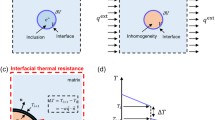Summary
Nanocomposites are modeled as a linearly elastic composite medium, which consists of a homogeneous matrix containing a statistically homogeneous random field of spheroid nanofibers with prescribed random orientation. An estimation of the effective thermoelastic properties of NC was performed by the effective field method (see Buryachenko, [10]) taking into account the random orientation of nanofibers as well as justified selection of spatial correlations of fiber location. The independent justified choice of shapes of inclusions and correlation holes provides the matrix of effective moduli which is symmetric (in contrast to the Mori-Tanaka approach). One estimates also the effective tensor of thermal expansion and stress concentrator factors depending on the orientation of the fiber being considered as well as on the justified choice of the shape of correlation holes, concentration and orientation distribution functions of nanofibers.
Similar content being viewed by others
References
Ijima, S.: Helical microtubes of graphitic carbon. Nature 354, 56–58 (1991).
Thess, A., Lee, R., Nicolaev, P. et al.: Crystalline ropes of metallic carbon nanotubes. Science 273, 483–487 (1996).
Thostenson, E. T., Ren, Z. F., Chou, T.-W.: Advances in the science and technology of carbon nanotubes and their composites: a review. Comp. Sci. Technol. 61, 1899–1912 (2001).
Qian, D., Wagner, G. J., Liu, W. K., Yu, M.-F., Ruoff, R. S.: Mechanics of carbon nanotubes. Appl. Mech. Rev. 55, 495–533 (2002).
Zhang, P., Huang, Y., Philippe, H. G., Hwang, K.: On the continuum modeling of carbon nanotubes. Acta Mech. Sin. 18, 528–536 (2002).
Qian, D., Dickey, E. C., Andrews, R., Rantell, T.: Load transfer and deformation mechanisms in carbon nanotube polystyrene composites. Appl. Phys. Lett. 76, 2868–2870 (2000).
Friesecke, G., James, R. D.: A scheme for the passage from atomic to continuum theory for thin films, nanotubes and nanorods. J. Mech. Phys. Solids 48, 1519–1540 (2000).
Odegard, G. M., Gates, T. S., Wise, K. E., Park, C., Siochi, E. J.: Constitutive modeling of nanotube-reinforced polymer composites. Comp. Sci Technol. 63, 1671–1687 (2003).
Tibbetts, G. G., McHugh, J. J.: Mechanical properties of vapor-grown carbon fiber composites with thermoplastic matrices. J. Mater Res. 14, 2871–2880 (1999).
Buryachenko, V. A.: Multiparticle effective field and related methods in micromechanics of composite materials. Appl. Mech. Rev. 54, 1–47 (2001).
Ruoff, R. S., Lorents, D. C.: Mechanical and thermal properties of carbon nanotubes. Carbon 33, 925–930 (1995).
Pipes, R. B., Hubert, P.: Helical carbon nanotube arrays: thermal expansion. Compos. Sci. Technol. 63, 1571–1579 (2003).
Shermergor, T. D.: The theory of elasticity of microinhomogeneous media. Moscow: Nauka 1977 (in Russian).
Christensen, R. M.: Mechanics of composite materials. New York: Wiley Interscience 1979.
Willis, J. R.: Variational and related methods for the overall properties of composites. Adv. Appl. Mech. 21, 1–78 (1981).
Mura, T.: Micromechanics of defects in solids. Dordrecht: Martinus Nijhoff 1987.
Kreher, W., Pompe, W.: Internal stresses in heterogeneous solids. Berlin: Akademie-Verlag 1989.
Nemat-Nasser, S., Hori, M.: Micromechanics: overall properties of heterogeneous materials. North-Holland: Elsevier 1993.
Torquato, S.: Random heterogeneous materials: microstructure and macroscopic properties. Berlin: Springer 2002.
Milton, G. W.: The theory of composites. Appl. Comput. Math. 6. Cambridge: Cambridge University Press 2003.
Lax, M.: Multiple scattering of waves II. The effective fields dense systems. Phys. Rev. 85, 621–629 (1952).
Ponte Castañeda, P., Willis, J. R.: The effect of spatial distribution on the effective behavior of composite materials and cracked media. J. Mech. Phys. Solids 43, 1919–1951 (1995).
Mori, T., Tanaka, K.: Average stress in matrix and average elastic energy of materials with misfitting inclusions. Acta Metall. 21, 571–574 (1973).
Willis, J. R.: Variational and related methods for the overall properties and self-consistent estimates for the overall properties. J. Mech. Phys. Solids 25, 185–203 (1977).
Norris, A. N.: An examination of the Mori-Tanaka effective medium approximation for multiphase composites. ASME J. Appl. Mech. 56, 83–88 (1989).
Ferrari, M.: Asymmetry and the high concentration limit of the Mori-Tanaka effective medium theory. Mech. Mater. 11, 251–256 (1991).
Benveniste, Y., Dvorak, G. J., Chen, T.: On diagonal and elastic symmetry of the approximate effective stiffness tensor of heterogeneous media. J. Mech. Phys. Solids 39, 929–946 (1991).
Pettermann, H. E., Böhm, H. J., Rammerstorfer, F. G.: Some direction dependent properties of matrix inclusion type composites with given reinforcement orientation distributions. Composites 28B, 253–265 (1997).
Böhm, H. J., Eckschlager, A., Han, W.: Multi-inclusion unit cell models for metal matrix composites with randomly oriented discontinuous reinforcements. Comput. Mater. Sci. 25, 42–53 (2002).
Duschlbauer, D., Pettermann, H. E., Böhm, H. J.: Mori-Tanaka based evaluation of inclusion stresses in composites with nonaligned reinforcements. Script. Mater. 48, 223–228 (2003).
Weng, G. J.: The theoretical connection between Mori-Tanaka’s theory and the Hashin–Shtrikman–Walpole bounds. Int. J. Engng Sci. 28, 1111–1120 (1990).
Gel’fand, I. M., Milos, R. A., Shapiro, S. Y.: Representations of the rotation and Lorentz groups and their applications. Oxford: Pergamon 1963.
Spencer, A. J. M.: Continuum mechanics. New York: Wiley 1980.
Kumar, A., Dawson, P. R.: Modeling crystallographic texture evolution with finite elements over neo-Eulerian orientation spaces. Comput. Meth. Appl. Mech. Engng 153, 259–302 (1998).
Morawiec, A., Field, D. P.: Rodrigers parameterization for orientation and misorientation distributions. Phil. Mag. A73, 1113–1130 (1996).
Eshelby, J. D.: The determination of the elastic field of an ellipsoidal inclusion, and related problems. Proc. R. Soc. London, Ser. A 241, 376–396 (1957).
Benveniste, Y.: A new approach to application of Mori–Tanaka’s theory in composite materials. Mech. Mater. 6, 147–157 (1987).
Tandon, G. P., Kim, R. Y., Rice, B. P.: Influence of vapor-grown carbon nanocomposites on thermomechanical properties of graphite-epoxy composites. Proc. Am. Soc. Composites 17th Techn. Conf. Purdue University, West Lafayette, Indiana, Paper 2039 (2002).
Lafdi, K., Matzek, M.: Carbon nanofibers as a nano-reinforcement for polymeric nanocomposites. 35th Int. SAMPE Techn. Conf., Dayton, Ohio (2003).
Buryachenko, V. A., Roy, A.: Effective elastic moduli of nanocomposites with prescribed random orientation of nanofibers. Composites B. (in press)
Author information
Authors and Affiliations
Corresponding author
Rights and permissions
About this article
Cite this article
Buryachenko, V.A., Roy, A. Effective thermoelastic moduli and stress concentrator factors in nanocomposites. Acta Mechanica 177, 149–169 (2005). https://doi.org/10.1007/s00707-005-0228-0
Received:
Published:
Issue Date:
DOI: https://doi.org/10.1007/s00707-005-0228-0



